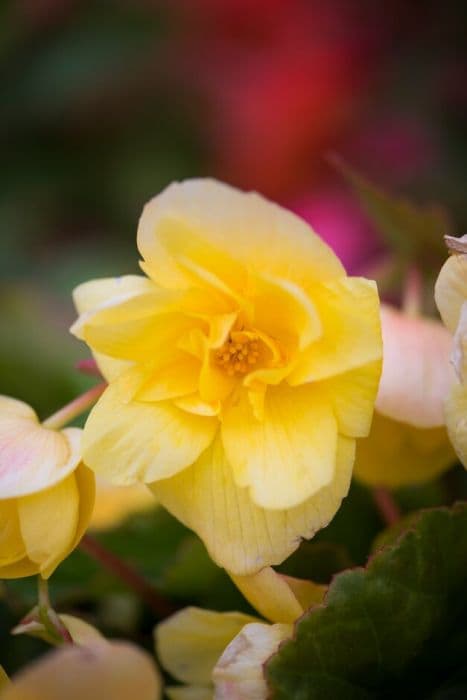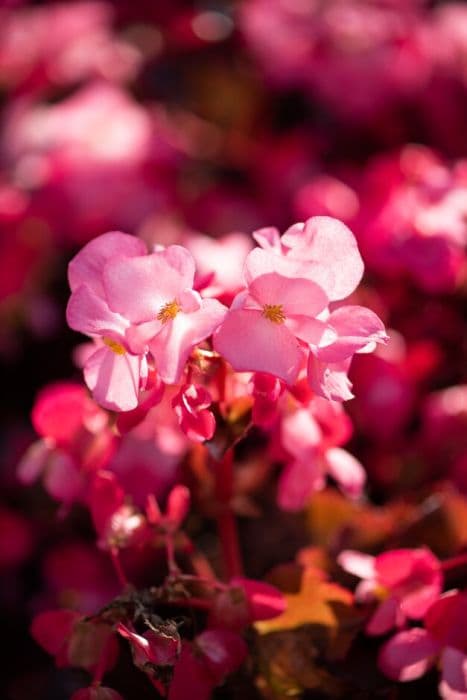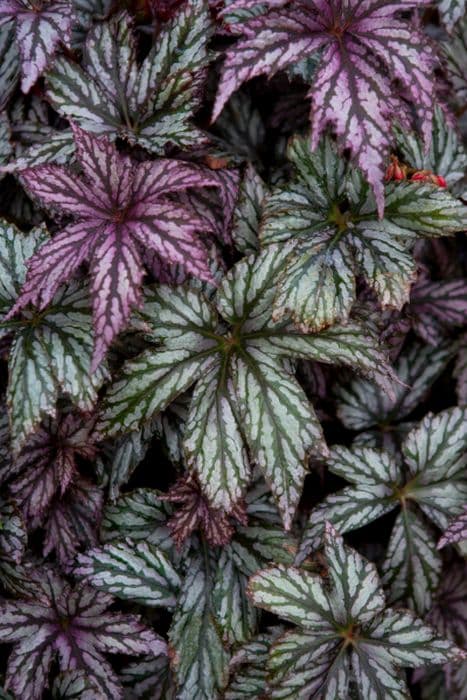Wax Begonia Begonia 'Dewdrop' (R)

ABOUT
The Begonia 'Dewdrop' presents a lush and vibrant appearance, characteristic of many begonias. It boasts a generous profusion of foliage that is as attractive as it is vigorous. The leaves exhibit a green coloration that can range from a rich, deep shade to a lighter, more vibrant hue. The texture of the leaves is noteworthy, commonly showing a glossy surface with a slightly waxy touch which catches and reflects light, making the plant look dew-kissed—which is likely where it gets its 'Dewdrop' nickname. Adding to its visual interest, the leaf edges are often delicately scalloped or may present with a subtle serration, contributing to the ornamental quality of the plant. Depending on the individual specimen, the leaf shape can vary but usually includes a broad base tapering to a point, offering a heart-shaped or oblong expression. The Begonia 'Dewdrop' blooms with flowers that can be a stunning contrast or complement to its foliage. The flowers are generally small but abundant, adding a dainty charm to the plant's robust greenery. They may appear in various shades including white, pink, or red, and are typically clustered in small bunches, giving a cheerful display of color that can persist over several months under the right conditions. Overall, the Begonia 'Dewdrop' is a sumptuous addition to any plant collection or garden with its harmonious blend of decorative foliage and delightful flowering performance.
About this plant
 Names
NamesSynonyms
Dewdrop Begonia, Dragon Wing Begonia, Angel Wing Begonia.
Common names
Begonia 'Dewdrop'
 Toxicity
ToxicityTo humans
Begonia 'Dewdrop' is considered non-toxic to humans. Generally, ingestion of this plant does not cause serious harm or toxicity. However, it may cause mild irritation or discomfort in the mouth if chewed on. It's still advisable not to consume any part of ornamental plants as a precaution.
To pets
Begonia 'Dewdrop' is considered mildly toxic to pets, particularly cats and dogs. If ingested, it can cause symptoms such as salivation, vomiting, and difficulty swallowing due to irritation of the mouth and the gastrointestinal tract. Owners should keep their pets away from this plant to prevent any potential negative reactions.
 Characteristics
CharacteristicsLife cycle
Perennials
Foliage type
Evergreen
Color of leaves
Green
Flower color
Varies
Height
1-1.5 feet (30-45 cm)
Spread
1-1.5 feet (30-45 cm)
Plant type
Herb
Hardiness zones
10
Native area
Central and South America
Benefits
 General Benefits
General Benefits- Ornamental Value: The Begonia 'Dewdrop' adds aesthetic beauty to gardens and homes with its vibrant flowers and attractive foliage.
- Low Maintenance: It requires minimal care, making it ideal for busy gardeners or those new to plant care.
- Drought Tolerance: Once established, it can withstand periods without water better than many other plants.
- Variety in Use: It can be grown in pots, hanging baskets, or directly in the ground in suitable climates.
- Adaptability: The plant can adapt to various light conditions, though it prefers bright, indirect light.
- Fast Growth: It tends to grow quickly, providing a quicker display of flowers and foliage.
 Medical Properties
Medical PropertiesThis plant is not used for medical purposes.
 Air-purifying Qualities
Air-purifying QualitiesThis plant is not specifically known for air purifying qualities.
 Other Uses
Other Uses- Topiary Art: Begonias like 'Dewdrop' can be shaped and maintained as a part of topiary gardens due to their dense foliage and ease of pruning.
- Photography Subjects: With their vibrant colors and interesting flower shapes, 'Dewdrop' Begonias can be used as photogenic subjects for botanical photography or art projects.
- Leaf Castings: The distinctive leaves of 'Dewdrop' Begonias can be used to create decorative leaf castings for garden accents or artistic pieces.
- Fairy Gardens: These Begonias can be incorporated into fairy gardens thanks to their compact size and whimsical appearance, creating a magical miniature landscape.
- Educational Tool: Begonia 'Dewdrop' can be used in schools or educational programs to teach children about plant care and horticulture.
- Floral Arrangements: The blooms and foliage of 'Dewdrop' Begonias make them suitable for fresh or dried floral arrangements.
- Seasonal Decor: Potted Begonia 'Dewdrop' can be used as living decor for fall or spring holiday table settings for a natural touch.
- Landscape Borders: These Begonias can be planted in rows to create vivid landscape borders or pathway linings in gardens or parks.
- Gift Plants: Due to their attractiveness and relatively easy care, 'Dewdrop' Begonias make great gift plants for garden enthusiasts or as housewarming presents.
- Crafting: Creative crafters can use Begonia 'Dewdrop' flowers and leaves to embellish handmade cards, scrapbooks, or to create botanical prints.
Interesting Facts
 Feng Shui
Feng ShuiThe Begonia is not used in Feng Shui practice.
 Plant Symbolism
Plant Symbolism- Caution: Begonias often symbolize a sense of caution or warning. The "Dewdrop" variety, with its delicate appearance, could suggest being gentle in one's approach or treading lightly in new situations.
- Harmony: This plant may represent harmony, particularly through the balanced and symmetrical shape of its foliage and flowers. "Dewdrop" suggests a peaceful and serene environment.
- Uniqueness: Owing to the distinctive qualities of the 'Dewdrop' variety, it can symbolize individuality and the celebration of one's unique attributes.
- Gratitude: Begonias have been known to symbolize gratitude. Gifting a 'Dewdrop' Begonia could be a gesture of thanks or appreciation.
 Water
WaterWax Begonias like the 'Dewdrop' variety should be watered when the top inch of soil feels dry to the touch. It is important to water them thoroughly, so the water reaches the roots, but care must be taken to avoid waterlogging the soil. On average, this might be approximately every 5 to 7 days, depending on environmental conditions such as temperature and humidity. Each watering session might entail giving the plant around 8 to 16 ounces of water for a pot with a diameter of 6 inches. Always reduce the frequency of watering during the cooler months when the plant's growth slows down
 Light
LightWax Begonias, such as the 'Dewdrop,' thrive best in bright, indirect sunlight. They can also tolerate some direct morning sunlight, but harsh afternoon sun can damage the foliage. The ideal spot for a 'Dewdrop' Begonia is near a window with a sheer curtain that provides bright but diffused light. East or west-facing windows are often suitable locations for these plants
 Temperature
TemperatureThe Wax Begonia 'Dewdrop' prefers a temperature range between 60°F and 75°F, which is ideal for robust growth. They can survive in temperatures as low as 50°F and as high as 86°F, but the extremes should be avoided to prevent stress on the plant. Consistent temperatures within the ideal range will help maintain the health and flowering of the 'Dewdrop' Begonia
 Pruning
PruningPruning Wax Begonias, such as 'Dewdrop,' helps encourage bushier growth and remove any dead or diseased foliage. Lightly pinch or trim the tips of the stems periodically through the growing season to promote a more compact shape. The best time to prune is in late winter or early spring before new growth begins. This can be performed every few months or as needed to maintain the desired plant shape and size
 Cleaning
CleaningAs needed
 Soil
SoilThe best soil mix for a Begonia 'Dewdrop', commonly known as a Wax Begonia, is a well-draining potting mix with peat, perlite, and vermiculite. A pH range of 5.5-6.5 is ideal for these begonias.
 Repotting
RepottingWax Begonias should typically be repotted every 1-2 years or when they become root-bound. Fresh soil helps maintain nutrient availability and proper soil structure.
 Humidity & Misting
Humidity & MistingWax Begonias thrive at humidity levels ranging from 50% to 70%. High humidity is essential for promoting lush growth and vibrant foliage.
 Suitable locations
Suitable locationsIndoor
Place Wax Begonias near bright, indirect light away from drafts.
Outdoor
Grow Wax Begonias in shade and protect from harsh weather.
Hardiness zone
10-11 USDA
 Life cycle
Life cycleBegonia 'Dewdrop' typically starts its life as a seed, which, when sown in warm, moist soil and with adequate light, will germinate into a small seedling. The seedling grows into a juvenile plant, developing characteristic fleshy leaves and stems, a phase which may vary in length depending on environmental conditions. As it matures, the begonia enters its vegetative stage, during which it grows larger, produces more leaves, and can be propagated through stem or leaf cuttings. Once it reaches maturity, it enters the flowering stage, producing clusters of delicate flowers that can be white, pink, or red, often during warmer months of the year. After pollination, the flowers will produce seeds, completing the reproductive cycle, if conditions allow. The life span of the individual Begonia 'Dewdrop' plant can vary, but with proper care, it can live for several years before naturally declining.
 Propogation
PropogationPropogation time
Spring to Summer
The Begonia 'Dewdrop' is commonly propagated through stem cuttings, a process best done in spring or early summer. The most popular method involves taking a healthy stem cutting about 4 to 6 inches (10 to 15 cm) long, ensuring there are a few leaves on it. The lower leaves are removed, and the cut end is dipped in rooting hormone to encourage root growth. This cutting is then placed in moist, well-draining potting mix or sometimes directly into water for root development. If using soil, the pot should be kept in a warm location with bright, indirect light and the soil should be kept consistently moist but not waterlogged. Roots will typically begin to form within a few weeks, after which the new plant can be gradually transitioned to normal care conditions for Begonias.





![Begonia [Devotion]](/_next/image?url=https%3A%2F%2Fplants-admin.emdemapps.com%2Fimages%2Fplants%2F%2Fimages%2F604b58183573b.png&w=640&q=75)



